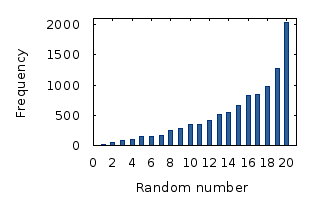def fitness(source, target):
fitval = 0
for i in range(0, len(source)):
fitval += (ord(target[i]) - ord(source[i])) ** 2
return(fitval)
If you look closely, you'll notice that for each character, I square the difference. This is to to put extra emphasis on larger differences. If we don't do this, the string "Hannp" would have a fitness of 0. You see, the difference between 'e' and 'a' is -5, between 'l' and 'n' is +2 (which we have twice) and between 'o' and 'p' is +1. Adding these up yields a fitness of 0, but it's not the string we want at all. If we square the differences, they become 25, 4, 4 and 1, which yields a fitness of 34. Effectively, we square each difference so that they can't cancel each other out.
Now we need to introduce mutations into our string. This is rather easy. We simply pick a random character in the string, and either increment or decrease it by one, or leave it alone:
def mutate(source):
charpos = random.randint(0, len(source) - 1)
parts = list(source)
parts[charpos] = chr(ord(parts[charpos]) + random.randint(-1,1))
return(''.join(parts))
Time to tie the whole shabang together!
fitval = fitness(source, target)
i = 0
while True:
i += 1
m = mutate(source)
fitval_m = fitness(m, target)
if fitval_m < fitval:
fitval = fitval_m
source = m
print "%5i %5i %14s" % (i, fitval_m, m)
if fitval == 0:
break
This should be easy enough to understand. For each iteration of the While-loop, we mutate the string and then calculate its fitness. If it is fitter then the original string (the parent), we make the child the new string. Otherwise, we throw it away. If the fitness is 0, we're done!
Lets look at some output. I'm snipping out some intermediary output cause it's not terribly interesting.
At generation 1, we have a fitness of 15491, and the string looks nothing like "Hello, World!". The same for generation 20, 40, 60, etc.
1 15491 jjKnp4bqpmAbp
20 15400 jiKnp3bppoAbp
40 15377 jiKlo2bpooAdp
60 15130 iiKlo2aoooAdp
Not much progress so far. At generation 500 it's still a load of nonsense:
500 9986 eTlo,YaorNdf
Generation 1200, we start to see something that looks like "Hello, World!":
1200 4186 Heglo,LWorhdP
Generation 1500, we're getting very close!
1500 3370 Hello,GWorldL
It still takes a good 1500 generations more before we're finally there:
3078 2 Hello, Vorld"
3079 2 Hfllo, World"
3080 2 Hfllo, World"
3081 0 Hello, World!
There it is!
A better, more interesting, algorithm
Okay, so that worked. But... it was kinda lame. Nothing interesting to see, really, was there? That's because our algorithm was a little too simplistic. Only one "organism" in the gene pool, only one character mutated at any time. We can do better than that, so let's modify the program to make it more interesting.
We're not going to touch our fitness function, since that works rather well. Instead, lets introduce a genepool. Instead of having only one string, why not have a whole bunch or randomly generated strings and let them duke it out among themselves. That sounds a bit more real-life, doesn't it?
GENSIZE = 20
genepool = []
for i in range(0, GENSIZE):
dna = [random.choice(string.printable[:-5]) for j in range(0, len(target))]
fitness = calc_fitness(dna, target)
candidate = {'dna': dna, 'fitness': fitness }
genepool.append(candidate)
This little snippet generates a genepool with 20 random strings and their fitnesses.
Now, lets modify our mutation function. Instead of mutating one single character, we feed it two parents, picked at random from the genepool, and it will mix their DNA together a bit. It will also randomly mutate one character in the resulting DNA. It then returns the newly fabricated child, including its fitness.
def mutate(parent1, parent2):
child_dna = parent1['dna'][:]
# Mix both DNAs
start = random.randint(0, len(parent2['dna']) - 1)
stop = random.randint(0, len(parent2['dna']) - 1)
if start > stop:
stop, start = start, stop
child_dna[start:stop] = parent2['dna'][start:stop]
# Mutate one position
charpos = random.randint(0, len(child_dna) - 1)
child_dna[charpos] = chr(ord(child_dna[charpos]) + random.randint(-1,1))
child_fitness = calc_fitness(child_dna, target)
return({'dna': child_dna, 'fitness': child_fitness})
We also need a routine to pick two random parents from the genepool. Now, we could just pick them completely random, but what you really want is for parents with a good fitness to have a better chance of offspring. If we sort the genepool list by fitness, we can use a uniform product distribution to make sure that parents with better fitness get chosen more often.
Now you might ask, what the hell is a uniform product distribution? When you randomly pick a number between, say, one and ten, each number has the same chance of being picked. This is called a "uniform distribution". But when you pick two random numbers, and you multiply them, there's a much bigger chance of getting a bigger number than a smaller number. Hence the name "uniform product distribution". Here's how that looks:

So our random parent picker will do just that. We select two random real numbers between 0 and 1, multiple those two random numbers and then scale the result up to our poolsize by multiplying the result with the size of the pool. We return that parent from the pool.
def random_parent(genepool):
wRndNr = random.random() * random.random() * (GENSIZE - 1)
wRndNr = int(wRndNr)
return(genepool[wRndNr])
There! Now it's time for our main loop
while True:
genepool.sort(key=lambda candidate: candidate['fitness'])
if genepool[0]['fitness'] == 0:
# Target reached
break
parent1 = random_parent(genepool)
parent2 = random_parent(genepool)
child = mutate(parent1, parent2)
if child['fitness'] < genepool[-1]['fitness']:
genepool[-1] = child
For each iteration of the While True loop, we first sort the genepool by fitness so that the most fit parents are at the top. We check to see if the fittest happens to be the target string we're looking for. If so, we stop the loop.
Then we select two parents from the genepool using the uniform product distribution so that fitter parents are chosen more often. We create a bastard mutated child that will mix both parents' DNA together and introduce a little mutation. If the new child is more fit than the worst in the genepool, it will replace that degenerate one in the genepool. In the next iteration, the pool is sorted again on fitness so that the new child takes its rightful place.
Results
Now it's time to run this puppy and see what it does. Again, I snip out some of the less interesting stuff.
Here's the genepool in the beginning. The first number is the generation (the number of times the While-loop has run), the second number the fitness and the third column is the DNA for that entry in the genepool.
1 7617 'iSx{$,K`u~(B
1 9284 SQf`1N#UdrPlT
1 12837 sYIu<E"Fq'^_.
1 15531 DC8Dg1I$*mUs-
1 16064 L~*}JBVdF7bu2
1 16533 1,XU%)5$q[YuO
1 16588 ff],ceW<0fud&
1 17316 [V3@2'VgY{KV
1 17356 kWw#v/P<#apG9
1 17581 <Lrh(1hN_Bd)3
1 18777 TM]_]TbtxFY:q
1 19656 $zS+EI?BS>%z(
1 19841 =S;B~((W8 D,6
1 20398 P_A$D|NPJPio/
1 21957 J&f=O:g8'{S2
1 22543 5*T2c"pMZ80L'
1 24954 A&lZ#A_}MxI"P
1 25186 &9MrI|0&x)q,N
1 28110 OlXT/Q{y3{"LR
1 29656 8WB99hx%0]}h[
One big random jumbled mess. Note the ones I've emphasized. These are the parents that were selected for the new child in the next generation. Lets see how it looks after one generation:
2 7617 'iSx{$,K`u~(B
2 8742 SQf`1N#UdfumT
2 9284 SQf`1N#UdrPlT
2 12837 sYIu<E"Fq'^_.
2 15531 DC8Dg1I$*mUs-
2 16064 L~*}JBVdF7bu2
2 16533 1,XU%)5$q[YuO
2 16588 ff],ceW<0fud&
2 17316 [V3@2'VgY{KV
2 17356 kWw#v/P>#apG9
2 17581 <Lrh(1hN_Bd)3
2 18777 TM]_]TbtxFY:q
2 19656 $zS+EI?BS>%z(
2 19841 =S;B~((W8 D,6
2 20398 P_A$D|NPJPio/
2 21957 J&f=O:g8'{S2
2 22543 5*T2c"pMZ80L'
2 24954 A&lZ#A_}MxI"P
2 25186 &9MrI|0&x)q,N
2 28110 OlXT/Q{y3{"LR
Two random parents from the previous generation have their DNA mixed, and have generated an offspring (the bold one) which is better then both of them. It comes in second with a fitness of 8742, while its parents only had fitness of 9284 and 16588. Lets skip ahead a bit and look at the 6th generation:
6 7617 'iSx{$,K`u~(B
6 8742 SQf`1N#UdfumT
6 9284 SQf`1N#UdrPlT
6 10198 SQfD1N#UdfumT
6 12837 sYIu<E"Fq'^_.
6 15531 DC8Dg1I$*mUs-
6 16064 L~*}JBVdF7bu2
6 16387 SQf`1N"MZ80LT
6 16533 1,XU%)5$q[YuO
6 16588 ff],ceW<0fud&
6 17316 [V3@2'VgY{KV
6 17356 kWw#v/P>#apG9
6 17356 kWw#v/P>#apG9
6 17581 <Lrh(1hN_Bd)3
6 18777 TM]_]TbtxFY:q
6 19656 $zS+EI?BS>%z(
6 19841 =S;B~((W8 D,6
6 20287 fe],1eW<0fud&
6 20398 P_A$D|NPJPio/
6 21957 J&f=O:g8'{S2
As you can see, the "SQf" has reproduced again with success, and there are now four variants of it in the genepool. We also note the "kWw#", which there are two identical ones of. This can happen when the entire DNA of one parent is copied and no mutation occurs. In our mutate function, we use the first parent's DNA as a base and then randomly overlay some of the seconds parent's DNA. This can anything from the entire second parent's DNA, or nothing at all. But generally, the chance is higher that the first parent's DNA survives largely in tact.
The next interesting generation is 13:
13 4204 RQf`{$,KdfumT
13 7617 'iSx{$,K`u~(B
13 7617 'iSx{$,K`u~(B
13 8742 SQf`1N#UdfumT
13 8742 SQf`1N#UdfumT
13 9284 SQf`1N#UdrPlT
13 9284 SQf`1N#UdrPlT
13 10198 SQfD1N#UdfumT
13 12837 sYIu<E"Fq'^_.
13 15531 DC8Dg1I$*mUs-
13 15838 L~*xJBVdG7bu2
13 15856 $zS+<E"Fq(^_(
13 15883 L~*xJCVdG7bu2
13 16064 L~*}JBVdF7bu2
13 16387 SQf`1N"MZ80LT
13 16533 1,XU%)5$q[YuO
13 16588 ff],ceW<0fud&
13 17316 [V3@2'VgY{KV
13 17356 kWw#v/P>#apG9
13 17356 kWw#v/P>#apG9
Wow! "SQf" has been really busy and now almost rules the genepool. "iSx" is second and third, but has lost its number one position to the "RQf" variant of "SQf". "RQf" was introduced in the 12th generation as a child of an "iSx" and "SQf" variant. We see that "kWv" has been knocked almost to the end of the list by more fit candidates. It is very obvious that this pool is no longer random. Patterns are starting to emerge all over it.
By the time we reach generation 40:
40 3306 RQSw{$-KcfumB
40 4204 RQf`{$,KdfumT
40 4229 RQf`|$,KdfumT
40 4242 RQe`|$,KdfumT
40 4795 RQSw{$-KdfumT
40 4971 RQSwz$*K`uSnT
40 4973 RQSwz$+K`uSmT
40 4992 RQSwz$+K`uSnT
40 5017 SQSxz$+K`uSmT
40 5017 SQSxz$+K`uSmT
40 5951 (QSxz$+KdfSmT
40 5985 'QSxz$+K`uSmT
40 6421 SQfx{$+K`u~(B
40 6444 TQf`{$+K`u~(B
40 6489 SQfx{$+KdfS(B
40 6492 TQf`{$-K`u~(B
40 7034 SQSxy$+KdfS(B
40 7617 'iSx{$,K`u~(B
40 7617 'iSx{$,K`u~(B
40 7625 'iS`{$,Kdg~(B
The genepool is now almost entirely dominated by the "RQf" variants. Forms of its original parents "SQf" and "iSx" can still be found here and there, although "iSx" is almost entire gone from the pool. An interesting thing is that we can see combinations of letters (bold) that keep reappearing. These are almost like actual genes! Combinations of DNA that work well together and therefor stay in the genepool in that combination. It takes lots of generations to make variants of these genes that are more fit then previous versions.
The next milestone is found in the 67th generation:
67 3138 RQSw{$+Kd*censored*A
67 3161 RQSw{$+Kc*censored*A
67 3176 RQSw{$,KdfulA
67 3176 RQSw{$+KcfulA
67 3218 RQSw{$-LcfumA
67 3222 RQSw{%,KefumB
67 3237 RQSw{$-LcfvmA
67 3241 RQSw{$-KcfumA
67 3241 RQSw{$-KcfumA
67 3266 RQSw{$-KceumA
67 3266 RQSw{$-KceumA
67 3267 RRSw{$-KcfumB
67 3289 RQSw{%,KefumC
67 3306 RQSw{$-KcfumB
67 3306 RQSw{$-KcfumB
67 3323 RQSw{#-KcfumB
67 3324 RPSw{$-KdfumB
67 3331 RQSw{$-KbfumB
67 3348 RQSw{#-KbfumB
67 3489 RQSw{$+KdfumA
This marks the first generation where there are no other variations then the RQS one. But immediately, we see the next generation in which a new number one is found:
68 3119 QQSw{$+Kd*censored*A
68 3138 RQSw{$+Kd*censored*A
68 3161 RQSw{$+Kc*censored*A
By the 96th generation, QQS has taken over the top:
96 3060 QQSw{%+KdhukA
96 3065 QRSw{%+Kd*censored*A
96 3081 QQSw{%+KdgukA
96 3081 QQSw{%+KdgukA
96 3081 QQSw{%+KdgukA
96 3096 QQSw{$+KdgukA
96 3104 QQSw{%+Kd*censored*A
96 3119 QQSw{$+Kd*censored*A
96 3119 QQSw{$+Kd*censored*A
96 3119 QQSw{$+Kd*censored*A
96 3137 RRSw{$,KdfulA
96 3137 RRSw{$,KdfulA
96 3138 RQSw{$+Kd*censored*A
96 3138 RQSw{$+Kd*censored*A
96 3138 RQSw{$+Kd*censored*A
96 3138 RQSw{$+Kd*censored*A
96 3138 RQSw{$+Kd*censored*A
96 3142 QQSw{$,Kd*censored*A
96 3142 QQSw{$+Kc*censored*A
96 3144 QQSw|$+Kd*censored*A
This is where the race gets boring. Every now and then a new, better, mutation will arise and take over the genepool. Change is slow though, and no big surprised are left. The candidates slowly but surely mutate until the reach something resembling the "Hello, World!" we are looking for in generation 1600:
1600 19 Hdllo+ Worle%
1600 20 Hdklo+ Worle%
1600 20 Hdklo+ Worle%
1600 20 Hdklo+ Worle%
1600 20 Hdklo+ Worle%
1600 20 Hdklo+ Workd%
It takes almost another half-thousand generation to get to the final target:
1904 0 Hello, World!
1904 1 Hello, World"
1904 1 Hello, World"
1904 2 Hello, Wprld"
1904 2 Helmo, World"
1904 2 Helmo, World"
1904 2 Hdllo, World"
1904 2 Hello, Worle"
Interesting (if you're boring like me and you like this kind of stuff) facts:
- It usually takes anywhere between 2500 and 4000 generations to evolve the target.
- On average, it takes approximately 3100 generations to evolve the target.
- If we remove the parent DNA mixing and rely solely on mutations, it takes on average 3650 generations to evolve the target.
- The parent DNA mixing is only really useful in the beginning. In the first generations, it can quickly propel a new mix of DNA to the top of the list, but later on random mutations instead of mixing DNA becomes the main driving force between the evolution. (this doesn't have to be the case in real life evolution, naturally)
- Sometimes "beneficial" mutations disappear. For instance, the word "World" already appeared in mutation 1469, but was overtaken by other mutations quickly. It was pushed out of the genepool at generation 1486, only to reappear in generation 1659. From then on, it quickly rose to the top and dominated the top 5 positions of the genepool within 10 generations.
This entry was posted
on Wednesday, September 28th, 2011 at 12:47 am and is filed under math, programming, python.
You can follow any responses to this entry through the RSS 2.0 feed.


































 Them All!
Them All!














